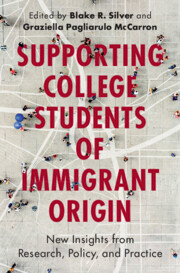Book contents
- Supporting College Students of Immigrant Origin
- Supporting College Students of Immigrant Origin
- Copyright page
- Dedication
- Contents
- Figures
- Tables
- Contributors
- Foreword
- Part I Beginnings
- Part II Experiences
- Chapter 6 Funds of Knowledge as Strategic Food and Campus Navigation at Selective, Affluent Universities
- Chapter 7 Psychosocial Stressors and Coping Strategies in Racially and Ethnically Diverse Undocumented College Students
- Chapter 8 How Colleges Can Support Working Students of Immigrant Origin
- Chapter 9 First-generation College Student Women of Immigrant Origin and Perspectives on the Role of Gender in their Experiences On- and Off-campus
- Chapter 10 Second-generation Afghan Immigrants Navigating Racial and Ethnic Identities in College
- Chapter 11 The COVID-19 Pandemic and Undocumented Hispanic/Latino/x College Men
- Part III Institutional Arrangements
- Part IV Looking Forward
- Epilogue
- Index
- References
Chapter 7 - Psychosocial Stressors and Coping Strategies in Racially and Ethnically Diverse Undocumented College Students
from Part II - Experiences
Published online by Cambridge University Press: 16 May 2024
- Supporting College Students of Immigrant Origin
- Supporting College Students of Immigrant Origin
- Copyright page
- Dedication
- Contents
- Figures
- Tables
- Contributors
- Foreword
- Part I Beginnings
- Part II Experiences
- Chapter 6 Funds of Knowledge as Strategic Food and Campus Navigation at Selective, Affluent Universities
- Chapter 7 Psychosocial Stressors and Coping Strategies in Racially and Ethnically Diverse Undocumented College Students
- Chapter 8 How Colleges Can Support Working Students of Immigrant Origin
- Chapter 9 First-generation College Student Women of Immigrant Origin and Perspectives on the Role of Gender in their Experiences On- and Off-campus
- Chapter 10 Second-generation Afghan Immigrants Navigating Racial and Ethnic Identities in College
- Chapter 11 The COVID-19 Pandemic and Undocumented Hispanic/Latino/x College Men
- Part III Institutional Arrangements
- Part IV Looking Forward
- Epilogue
- Index
- References
Summary
This study used semi-structured interviews to examine daily stressors and coping resources as experienced by twenty-one racially and/or ethnically diverse, undocumented college students residing in Massachusetts (USA). A legal violence framework and stress process theory were used to analyze the stress and coping experiences of undocumented college students. The findings reveal the presence of financial burdens, fears of deportation, blocked opportunities, and legal status concealment as daily stressors, as well as needed peer and informational supports as coping resources for undocumented students. Furthermore, for undocumented students, fear of deportation and stigma hindered their ability to identify and capitalize on needed peer and institutional support. The authors argue that not recognizing the structural and symbolic ways that immigration laws serve as legitimizing sources for afflicting social, psychological, and material harm places students with precarious legal status at risk for poor mental health. This chapter concludes by offering practice implications to help improve the ability of institutional agents within higher education to meet the needs of undocumented college students.
- Type
- Chapter
- Information
- Supporting College Students of Immigrant OriginNew Insights from Research, Policy, and Practice, pp. 133 - 154Publisher: Cambridge University PressPrint publication year: 2024

